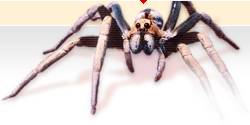
Emails claiming a spider "similar to huntsmen" (depicted is a photograph of Loxosceles) causes severe skin ulcerations is a hoax!
by Mark Harvey, Western Australian Museum
This email and images are a hoax that has been circulating on the web for quite some time. The images are apparently not the result of a brown recluse spider bite, but from some other ailment (possibly a snake bite), and they do not emanate from Australia. I first saw these images attached to emails several years ago, and they were warning people in California about the brown recluse spider. Someone has changed the email from California to Australia and it is being spread like wildfire over the internet.
The species in question and illustrated with a photograph - the Brown Recluse Spider (Loxosceles reclusa) - has never been found in Australia, although a related species occurs in Adelaide where they appear to have been accidentally introduced sometime in the past 100 years. They occur in sheds and garages and are not considered a problem. Indeed, there is no record of anyone being bitten by them, and if someone was bitten, the symptoms would be relatively benign, not like depicted in the images (progressive ulcerations of a thumb).
The Red Cross has declared that the information in the email does not emanate from them - see http://www.redcross.org.au/information_hoax.htm..
There are several websites available that treat this issue, for example http://www.hoax-slayer.com/brown-recluse.html specifically mentions the "spider heading for Western Australia" hoax. The most strident critic of these hoax emails is Rick Vetter from University of California, Riverside and his article at http://insects.about.com/od/spiders/tp/brown-recluse-lies.htm is very good.
The facts on fiddleback/hobo spiders (Loxosceles spp.) in Australia
by Julianne Waldock, Western Australian Museum
Brown spiders, Loxosceles laeta (Sicariidae), of Chile, Uruguay, Brazil, Ecuador, Peru and Argentina (and spread northward to Guatemala, Honduras, and some parts of the U.S. and Canada) have been known since the 1930's to cause severe illness. It was not until the 1950's, as a result of bites in Texas, Kansas, Missouri and Oklahoma, that the smaller Brown Recluse Spider, L. reclusa, was suspected to be similarly toxic. Loxosceles reclusa is native to the U.S. from south and central states.
Other species of Loxosceles are found in southwestern U.S. and in Mediterranean countries. Of these, L.rufescens, which probably originated from the Mediterranean region of Europe and Africa, has been recorded in Spain, France, Italy, the Balkans, Greece, southern Russia, all the North African countries, Madagascar, Israel, Burma, China, Japan, the eastern U.S., Mexico, Brazil, Paraguay, and many islands in the Atlantic Ocean.
The three above-mentioned species are the ones that can cause necrotic injuries. However, not all bites of these spiders result in severe injury, in some cases there may be no harm at all.
Australia
In 1974 Mike Gray (Australian Museum) reported the discovery of L. rufescens in Adelaide (specimens of L. rufescens had been in the South Australian Museum collection for more than 40 years) and L. rufipes in Sydney (based on only 3 specimens). The specimens from Sydney were subsequently identified as L. laeta (Harvey, 1996). No further specimens of L. rufipes/L. laeta have been found in Australia (Sutherland, 1983). In 1996 Mark Harvey reported the discovery of a single specimen of L. rufescens in the collection of the Western Australian Museum. This specimen had recently been donated to the collection and was originally collected in Nedlands "amongst packing boxes from Singapore" in 1957. No other specimens of Loxosceles have been recorded in New South Wales or Western Australia and no bites by these spiders have been recorded in Australia.
"Loxoscelism" (skin ulcerations) due to L. rufescens bites appears to be much milder than that produced by L. reclusa or L.laeta. Necrotic lesions as a result of Loxosceles bites are considered a less severe reaction in comparison to possible systemic illness which can result in coma and death within 72 hours. A recent publication of interest is Vetter, R.S. (2008) Spider of the genus Loxosceles (Araneae, Sicariidae): a review of biological, medical and psychological aspects regarding envenomations. The Journal of Arachnology 36, 150-163.
References
Sutherland, S. K. (1983). Australian Animal Toxins. Oxford University Press
Levi, H.W. and Levi, L.R. (1968). Spiders and their Kin. Golden Press, New York
Schenone, H. and Suarez, G. (1978). Venoms of Scytodidae. Genus Loxosceles. In Arthropod Venoms, Bettini, S. (ed.), Springer-Verlag
Harvey, M.S. (1996). Records of the Western Australian Museum 18, 223-224.
Forster, R. and Forster, L. (1999). The Spiders of New Zealand. University of Otago Press, Otago.

